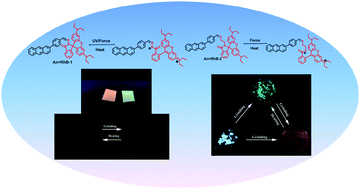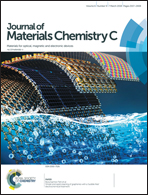Two novel rhodamine-based molecules with different mechanochromic and photochromic properties in solid state†
Abstract
Two novel molecules (An![[double bond, length as m-dash]](https://www.rsc.org/images/entities/char_e001.gif) RhB-1 and An
RhB-1 and An![[double bond, length as m-dash]](https://www.rsc.org/images/entities/char_e001.gif) RhB-2) were synthesized using Rhodamine B and anthracene as building units via Schiff base chemistry with different spacers. This small structural variation led to a dramatic difference in mechanochromic and photochromic properties in the solid state. They both showed a force-induced color change. However, An
RhB-2) were synthesized using Rhodamine B and anthracene as building units via Schiff base chemistry with different spacers. This small structural variation led to a dramatic difference in mechanochromic and photochromic properties in the solid state. They both showed a force-induced color change. However, An![[double bond, length as m-dash]](https://www.rsc.org/images/entities/char_e001.gif) RhB-1 not only displayed two color changes due to the ring-opening isomerization of the rhodamine derivatives, but also exhibited rarely reported photochromic properties. The photochromic behaviour of An
RhB-1 not only displayed two color changes due to the ring-opening isomerization of the rhodamine derivatives, but also exhibited rarely reported photochromic properties. The photochromic behaviour of An![[double bond, length as m-dash]](https://www.rsc.org/images/entities/char_e001.gif) RhB-1 resulted from its large free volume in the amorphous solid state and the relatively high stability of its zwitterionic species in its ring-open form. In contrast, An
RhB-1 resulted from its large free volume in the amorphous solid state and the relatively high stability of its zwitterionic species in its ring-open form. In contrast, An![[double bond, length as m-dash]](https://www.rsc.org/images/entities/char_e001.gif) RhB-2 gave a tricolored switch upon force action but no photochromic behavior is observed. The three-color variations in this molecule originated from the transformation of the different physical packing modes of anthracene and force-triggered chemical reaction of Rhodamine B lactam. The Schiff base group for the molecular design of mechanochromic and photochromic materials can be extended to other systems, which may open a new strategy to provide a broad perspective for the development of multi-stimuli responsive materials.
RhB-2 gave a tricolored switch upon force action but no photochromic behavior is observed. The three-color variations in this molecule originated from the transformation of the different physical packing modes of anthracene and force-triggered chemical reaction of Rhodamine B lactam. The Schiff base group for the molecular design of mechanochromic and photochromic materials can be extended to other systems, which may open a new strategy to provide a broad perspective for the development of multi-stimuli responsive materials.



 Please wait while we load your content...
Please wait while we load your content...